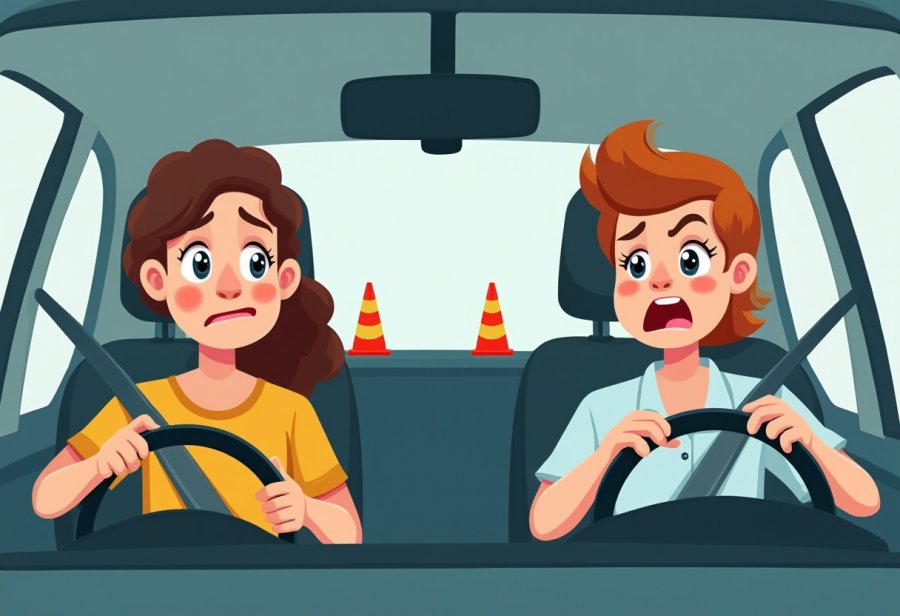Learning to drive marks a pivotal step toward independence, blending excitement with nerves as teens navigate their first moments behind the wheel. But does this rite of passage truly ease their internal struggles, or does it just mask deeper fears of failure and self-doubt? This journey isn’t solely about mastering controls—it’s an emotional transformation that builds resilience, patience, and confidence through incremental challenges and supportive feedback. As teens progress from quiet parking lots to busy streets, they learn that setbacks are part of growth, fostering a mindset of persistence and self-trust. Yet, beneath every confident maneuver lies an internal battle—managing nerves, overcoming fears, and embracing mistakes as opportunities. Could this process of internal growth be the key to more than just safe driving, but to developing lifelong resilience? Discover how internal transformation behind the wheel prepares teens to face future challenges with calm assurance and independence.

Stepping into Adulthood: The Significance of Learning to Drive
Learning to drive marks a major milestone in a teenager’s journey toward independence. It’s a moment filled with anticipation, a mix of excitement and nerves as teens prepare to take on a new level of responsibility. For many, getting behind the wheel isn’t just about learning how to operate a car—it’s a symbol that they’re stepping into adulthood, trusted to handle greater freedom and autonomy.
This process is about more than just mastering controls like steering, braking, or accelerating. It’s an emotional transition that signifies trust—trust from parents, instructors, and most importantly, from themselves—that they’re ready to navigate the world on their own. The act of driving becomes a tangible reminder that growth comes through effort, patience, and persistence, reinforcing their sense of capability with each successful mile.
Starting in calm, familiar environments—like quiet neighborhoods or empty parking lots—helps ease initial nerves. These controlled settings allow teens to focus on fundamental skills without feeling overwhelmed. As they gain confidence, they gradually progress to busier streets and highways, each new challenge building their resilience and self-assurance. This gradual approach keeps the learning curve manageable and safe, emphasizing that steady practice leads to steady growth.
Learning to drive isn’t just a technical skill—it’s a personal development journey. Teens learn to manage their nerves, cope with mistakes, and stay focused under pressure. Each small success, like smoothly executing a turn or parking confidently, reinforces their belief in their abilities. Conversely, setbacks teach patience and resilience, reminding them that mistakes are part of the process and opportunities to improve.
This milestone also shapes how teens see themselves. It’s a moment of trust—trust in their skills and trust from others—that signals they’re capable of handling responsibility. As their confidence grows, they start to view themselves as more independent and self-reliant. Recognizing the significance of this transition helps us understand that learning to drive is as much about internal growth as it is about external skills.
By the time teens are ready to hit the road on their own, they’ve already undergone a journey of emotional and practical development. What begins as nerves gradually fades into quiet confidence, built on small victories and lessons learned from setbacks. This internal transformation prepares them not just for responsible driving, but for navigating broader life challenges with calmness and resilience.
Building Confidence Behind the Wheel: Factors that Shape Teenage Driving Self-Assurance
Teenagers’ confidence behind the wheel doesn’t develop overnight; it’s shaped by a variety of experiences, support, and mindset. The more they practice in different conditions—whether it’s quiet neighborhoods or busy streets—the more familiar and manageable those situations become. Each successful maneuver, no matter how small, acts as a building block, reinforcing their belief that they can handle real-world driving challenges. Positive feedback from parents and instructors boosts self-esteem and encourages a can-do attitude, helping to turn nerves into steady confidence.
As teens gain experience, their confidence grows gradually. Starting in low-pressure environments like parking lots allows them to focus on mastering basics without feeling overwhelmed. Moving on to more complex scenarios, such as busy intersections or highway driving, is a step-by-step process that solidifies their skills and belief in their abilities. This incremental approach reduces anxiety and makes the learning curve feel more manageable, fostering a sense of control and trust in their capabilities.
Nerves are a natural part of learning to drive, but they can be managed effectively through simple strategies. Deep breathing exercises, for example, help calm physical signs of stress and sharpen focus. Breaking complex tasks into smaller, manageable steps—such as practicing merging or parallel parking separately—builds confidence through repetition and mastery. When teens recognize their progress and understand that mistakes are just part of learning, they develop a more positive outlook that encourages persistence and resilience.
Support from parents and instructors plays a crucial role in nurturing confidence. Celebrating small wins—like executing a tricky turn or parking confidently—reinforces their belief that they are capable. Creating a safe space for mistakes, where errors are seen as opportunities to learn rather than failures, helps teens take risks and try new skills. This steady reinforcement fosters internal trust, gradually replacing anxiety with calm assurance behind the wheel.
The development of confidence is also deeply connected to mindset. Viewing setbacks as opportunities rather than failures encourages teens to stay motivated. When they understand that mastery is built through persistence, they become more willing to face challenging situations with patience and curiosity. This growth mindset transforms initial nerves into quiet confidence, making them more resilient drivers and, ultimately, more independent individuals.
Psychological readiness influences how well teens absorb new skills and manage internal doubts. Techniques such as visualization or positive self-talk can help them stay centered in stressful moments. Managing emotions is vital—calm, focused drivers are better equipped to make sound decisions and react appropriately to unexpected situations. This emotional control becomes a core part of their confidence, extending beyond driving into other areas of life.
Over time, consistent practice and supportive feedback help teens develop a stable sense of self-trust. They start to see themselves as capable and responsible, which enhances their overall confidence. This internal growth not only makes them safer drivers but also prepares them to navigate other life challenges with calmness and resilience. Confidence, after all, is about feeling prepared to face the road—and life—with steadiness and purpose.

Overcoming Emotional Barriers: Navigating Nerves and Obstacles in Learning to Drive
Learning to drive is as much an emotional journey as it is a technical skill. Teens often grapple with internal hurdles like fear of making mistakes, self-doubt, and anxiety about safety. These feelings can slow their progress and make each new challenge seem overwhelming. Recognizing that such emotions are normal is key; every driver, regardless of age, experiences nerves at some point. What matters is how teens learn to manage and work through these feelings, turning obstacles into opportunities for growth.
Building resilience becomes essential. Teens need to understand that errors on the road aren’t failures but stepping stones. Each mistake offers a chance to learn and improve, gradually boosting confidence. Accepting imperfection helps reduce the fear of failure and encourages a calm, focused approach. Developing this mindset allows teens to stay centered during stressful moments, transforming anxiety into quiet strength.
Managing stress and emotions plays a crucial role in the learning process. Techniques like deep breathing or visualization can help teens stay composed when nerves threaten to take over. Breaking complex tasks into smaller, manageable steps—such as practicing merging or parallel parking separately—makes daunting challenges feel more approachable. When teens see their progress and understand that mistakes are part of learning, they develop a more positive outlook that fosters persistence and resilience.
The emotional landscape of driving often shapes how teens perceive themselves. Successfully navigating tricky situations or parking confidently begins to reshape their self-image into that of capable drivers. Conversely, persistent struggles can chip away at self-esteem. Supportive feedback from parents and instructors that emphasizes effort over perfection helps reinforce that confidence is built gradually through consistent practice. This approach encourages a growth mindset, turning setbacks into stepping stones rather than obstacles.
Handling setbacks with patience and self-compassion is vital for internal growth. When teens view mistakes as part of the learning journey, they become more willing to take risks and try new skills. This resilience not only improves their driving but also nurtures a broader confidence that extends into other areas of life. Learning to stay calm under pressure and embrace errors as opportunities to learn fosters a mindset of continuous growth, empowering teens to face future challenges with assurance.
For teens and their families seeking additional support and guidance, exploring resources on overcoming driving anxiety can be incredibly beneficial. One helpful option is to visit this comprehensive article on building driving confidence, which offers practical tips and strategies to further empower young drivers in their journey toward independence.
From Practice to Real Life: Applying Confidence and Calm in Everyday Driving Scenarios
As teens gain confidence behind the wheel, it naturally influences how they handle everyday driving situations. Instead of hesitating at simple tasks, they approach merging onto busy highways or navigating crowded parking lots with a calmer, more assured attitude. This newfound ease allows them to focus more on their surroundings and other drivers, rather than doubting every decision. As a result, their driving becomes smoother, safer, and more predictable, reducing stress for everyone on the road.
Managing nerves effectively also makes routine maneuvers feel less intimidating. Confident teens tend to plan ahead—checking mirrors, signaling early, and making deliberate moves—rather than rushing or second-guessing themselves. Whether it’s executing a tricky turn or parking in tight spots, they approach each challenge with a sense of control. This calm approach helps them stay alert and responsive, even in unpredictable traffic situations or adverse weather, turning potential stress points into opportunities to demonstrate their growing competence.
Parents and instructors play a vital role in translating this internal confidence into practical skills. Gradually increasing exposure to more complex driving environments—starting in quiet neighborhoods and progressing to busier streets—builds trust in their abilities. Praising small successes, like a smooth lane change or a confident parking maneuver, reinforces their belief that they can handle more. Creating an environment where mistakes are viewed as part of learning encourages teens to take risks and refine their skills without fear, fostering resilience and independence.
Applying these insights in real-life scenarios transforms driving from a nerve-wracking experience to a routine activity. Teens who manage their nerves well tend to follow traffic laws more diligently, make responsible decisions, and respond calmly to unexpected situations like sudden stops or aggressive drivers. This emotional resilience, combined with technical skills, enables them to navigate challenges with clarity and purpose. Over time, their driving becomes more intuitive, and their confidence naturally deepens, making each trip more enjoyable and less stressful.
Ultimately, the way teens internalize confidence and handle nerves shapes their broader approach to challenges beyond the road. The habits they develop—patience, focus, emotional control—become essential tools for facing future obstacles with steadiness. By turning each driving experience into an opportunity for growth, they not only become better drivers but also cultivate a mindset rooted in resilience and self-trust that will serve them well throughout life.

Journey of Growth: Embracing Self-Discovery and Resilience Through Driving
Learning to drive is more than just acquiring a set of skills; it’s a personal journey of growth and self-discovery. As teens transition from feeling nervous behind the wheel to gaining quiet confidence, they develop qualities like resilience, patience, and independence that extend far beyond the road. Each small victory—whether it’s executing a smooth parking move or merging onto a busy highway—serves as a milestone that reinforces their sense of capability and builds trust in their abilities. These moments remind them of their progress and fuel their motivation to keep pushing forward.
This process isn’t without setbacks. Mistakes and nerves are natural parts of learning, but they don’t define a driver or a person. Instead, they become opportunities to learn, adapt, and grow stronger. Cultivating a mindset that views challenges as stepping stones helps teens stay motivated and open to new experiences. Recognizing that confidence is built gradually through steady effort encourages persistence and resilience, turning each obstacle into a chance for internal growth.
Supporting teens through this phase means emphasizing effort over perfection. Every attempt, every successful maneuver, contributes to a broader sense of self-trust. When teens understand that progress matters more than flawlessness, they become more willing to take risks and learn from their experiences. This approach nurtures resilience and independence, qualities that will serve them well not only on the road but in many other areas of life.
As their confidence deepens, a clear internal shift occurs. Driving transforms from a source of anxiety into a symbol of self-reliance. Teens begin to see themselves as capable individuals who can handle responsibility and navigate challenges with calmness and clarity. This inner transformation often spills over into other aspects of their lives, fostering a broader sense of trust in their own judgment and emotional strength.
The journey of self-discovery behind the wheel ultimately prepares teens for a future where they face uncertainties with confidence and resilience. The skills and mindset they develop now become lifelong assets—tools to navigate not just roads but also life’s many challenges. Each mile driven is a step toward becoming a more confident, capable person, ready to embrace independence with both humility and strength.
Celebrating this growth is vital. Recognizing that nerves and mistakes are part of the process helps teens view their journey as a continuous one, not a final destination. When effort and persistence are valued more than perfection, teens are more motivated to push their boundaries and explore new levels of independence. This ongoing mindset fosters a sense of empowerment that will carry them through future challenges, both on and off the road.
The internal confidence gained from learning to drive shapes their broader approach to life. Patience, focus, and emotional control—developed through countless small experiences—become fundamental tools for facing future obstacles. They learn to stay calm under pressure, embrace errors as opportunities to grow, and trust in their ability to handle whatever comes next.
In the end, the journey of learning to drive is a microcosm of life’s larger path. It’s about more than just mastering a skill; it’s about building a resilient, self-assured mindset. As teens navigate this process, they lay the foundation for a future characterized by confidence, independence, and a readiness to face whatever roads lie ahead.






